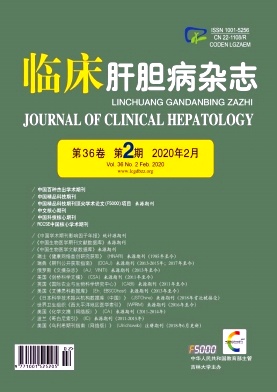|
[1] BRAY F,FERLAY J,SOERJOMATARAM I,et al. Global cancer statistics 2018:GLOBOCAN estimates of incidence and mortality worldwide for 36 cancers in 185 countries[J]. CA Cancer J Clin,2018,68(6):394-424.
|
|
[2] LEE SM,KIM HS,LEE S,et al. Emerging role of18F-fluorodeoxyglucose positron emission tomography for guiding management of hepatocellular carcinoma[J]. World J Gastroenterol,2019,25(11):1289-1306.
|
|
[3] PANT V,SEN IB,SOIN AS. Role of18F-FDG PET CT as an independent prognostic indicator in patients with hepatocellular carcinoma[J]. Nucl Med Commun,2013,34(8):749-757.
|
|
[4] KORNBERG A,SCHERNHAMMER M,FRIESS H.18F-FDGPET for assessing biological viability and prognosis in liver transplant patients with hepatocellular carcinoma[J]. J Clin Transl Hepatol,2017,5(3):224-234.
|
|
[5] MAZZAFERRO V,REGALIA E,DOCI R,et al. Liver transplantation for the treatment of small hepatocellular carcinomas in patients with cirrhosis[J]. N Engl J Med,1996,334(11):693-699.
|
|
[6] LI HB,FU HY,LU TY,et al. Key research advances in liver transplantation in 2017[J]. Ogran Transplantation,2018,9(1):41-50,82.(in Chinese)李海波,符洪源,陆桐宇,等.肝移植领域2017年度重要进展盘点[J].器官移植,2018,9(1):41-50,82.
|
|
[7] YAO FY,FERRELL L,BASS NM,et al. Liver transplantation for hepatocellular carcinoma:Expansion of the tumor size limits does not adversely impact survival[J]. Hepatology,2001,33(6):1394-1403.
|
|
[8] MARSH JW,DVORCHIK I,BONHAM CA,et al. Is the pathologic TNM staging system for patients with hepatoma predictive of outcome?[J]. Cancer,2000,88(3):538-543.
|
|
[9] LEE SG,HWANG S,MOON DB,et al. Expanded indication criteria of living donor liver transplantation for hepatocellular carcinoma at one large-volume center[J]. Liver Transpl,2008,14(7):935-945.
|
|
[10] DUBAY D,SANDROUSSI C,SANDHU L,et al. Liver transplantation for advanced hepatocellular carcinoma using poor tumor differentiation on biopsy as an exclusion criterion[J].Ann Surg,2011,253(1):166-172.
|
|
[11] MAZZAFERRO V,LLOVET JM,MICELI R,et al. Predicting survival after liver transplantation in patients with hepatocellular carcinoma beyond the Milan criteria:A retrospective,exploratory analysis[J]. Lancet Oncol,2009,10(1):35-43.
|
|
[12] ZHENG SS,WANG K,XU X,et al. Clinical value of Hangzhou Criteria in selection of patients with hepatocellular carcinoma for living donor liver transplantation[J]. Chin J Organ Transplant,2011,32(6):330-333.(in Chinese)郑树森,汪恺,徐骁,等.肝移植治疗肝癌的受者选择杭州标准在亲属活体供肝移植中的应用价值[J].中华器官移植杂志,2011,32(6):330-333.
|
|
[13] FAN J,ZHOU J,XU Y,et al. Indication of liver transplantation for hepatocellular carcinoma:Shanghai Fudan Criteria[J].Natl Med J China,2006,86(18):1227-1231.(in Chinese)樊嘉,周俭,徐泱,等.肝癌肝移植适应证的选择:上海复旦标准[J].中华医学杂志,2006,86(18):1227-1231.
|
|
[14] CHANG XJ,LU YY,RONG GH,et al. Risk factors for vascular invasion of primary liver cancer[J]. J Clin Hepatol,2018,34(5):1038-1041.(in Chinese)常秀娟,陆荫英,荣光华,等.原发性肝癌发生血管侵犯的危险因素分析[J].临床肝胆病杂志,2018,34(5):1038-1041.
|
|
[15] HSU CC,CHEN CL,WANG CC,et al. Combination of FDGPET and UCSF Criteria for predicting HCC recurrence after living donor liver transplantation[J]. Transplantation,2016,100(9):1925-1932.
|
|
[16] SUN DW,AN L,WEI F,et al. Prognostic significance of parameters from pretreatment(18)F-FDG PET in hepatocellular carcinoma:A meta-analysis[J]. Abdom Radiol(NY),2016,41(1):33-41.
|
|
[17] IJICHI H,SHIRABE K,TAKETOMI A,et al. Clinical usefulness of(18)F-fluorodeoxyglucose positron emission tomography/computed tomography for patients with primary liver cancer with special reference to rare histological types,hepatocellular carcinoma with sarcomatous change and combined hepatocellular and cholangiocarcinoma[J]. Hepatol Res,2013,43(5):481-487.
|
|
[18] WANG YT,ZUO CJ,ZHANG J,et al. Value of Fluorine-18-fluorodeoxyglucose PET/CT examination to predict microvascular invasion of hepatocellular carcinoma[J]. Chin J Dig Surg,2018,17(1):109-115.(in Chinese)王玉涛,左长京,张建,等.18氟-氟代脱氧葡萄糖PET/CT检查预测肝细胞癌微血管侵犯的价值[J].中华消化外科杂志,2018,17(1):109-115.
|
|
[19] KOBAYASHI T,AIKATA H,HONDA F,et al. Preoperative fluorine 18 fluorodeoxyglucose positron emission tomography/computed tomography for prediction of microvascular invasion in small hepatocellular carcinoma[J]. J Comput Assist Tomogr,2016,40(4):524-530.
|
|
[20] BAILLY M,VENEL Y,ORAIN I,et al.18F-FDG PET in liver transplantation setting of hepatocellular carcinoma:Predicting histology?[J]. Clin Nucl Med,2016,41(3):e126-e129.
|
|
[21] LIN CY,LIAO CW,CHU LY,et al. Predictive value of18FFDG PET/CT for vascular invasion in patients with hepatocellular carcinoma before liver transplantation[J]. Clin Nucl Med,2017,42(4):e183-e187.
|
|
[22] YANG SH,SUH KS,LEE HW,et al. The role of(18)F-FDG-PET imaging for the selection of liver transplantation candidates among hepatocellular carcinoma patients[J]. Liver Transpl,2006,12(11):1655-1660.
|
|
[23] KORNBERG A,WITT U,SCHERNHAMMER M,et al. Combining18F-FDG positron emission tomography with Up-toSeven criteria for selecting suitable liver transplant patients with advanced hepatocellular carcinoma[J]. Sci Rep,2017,7(1):14176.
|
|
[24] LEE SD,KIM SH,KIM SK,et al. Clinical impact of18F-fluorodeoxyglucose positron emission tomography/computed tomography in living donor liver transplantation for advanced hepatocellular carcinoma[J]. Transplantation,2015,99(10):2142-2149.
|
|
[25] REFAAT R,BASHA MAA,HASSAN MS,et al. Efficacy of contrast-enhanced FDG PET/CT in patients awaiting liver transplantation with rising alpha-fetoprotein after bridge therapy of hepatocellular carcinoma[J]. Eur Radiol,2018,28(12):5356-5367.
|
|
[26] TAKADA Y,KAIDO T,SHIRABE K,et al. Significance of preoperative fluorodeoxyglucose-positron emission tomography in prediction of tumor recurrence after liver transplantation for hepatocellular carcinoma patients:A Japanese multicenter study[J]. J Hepatobiliary Pancreat Sci,2017,24(1):49-57.
|







 DownLoad:
DownLoad: